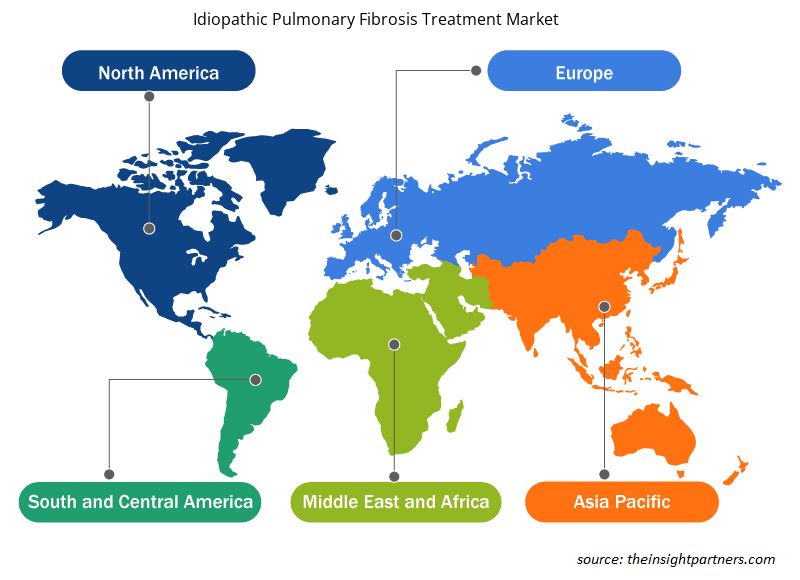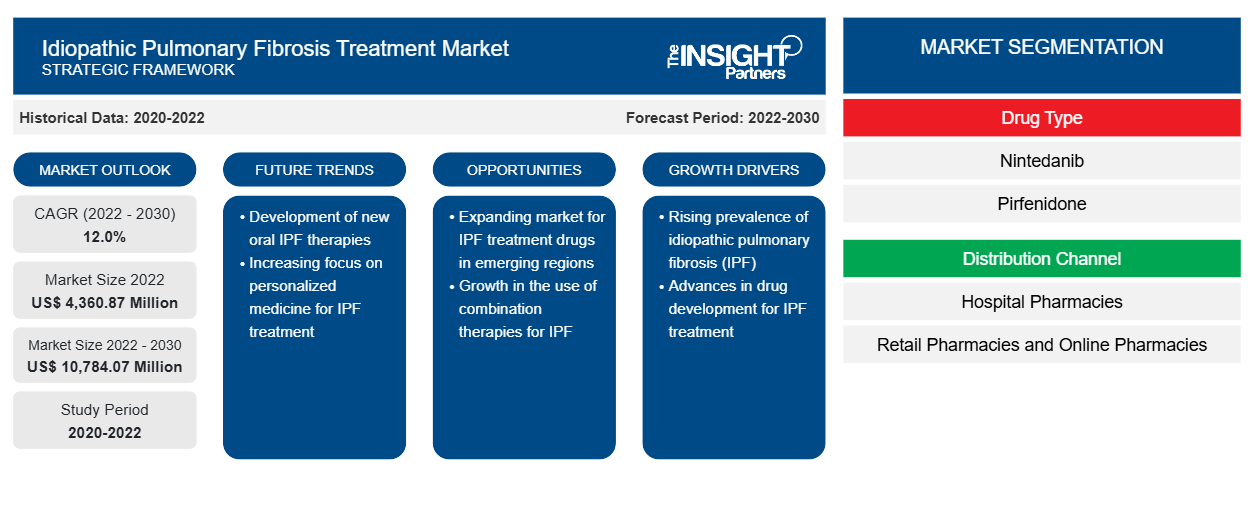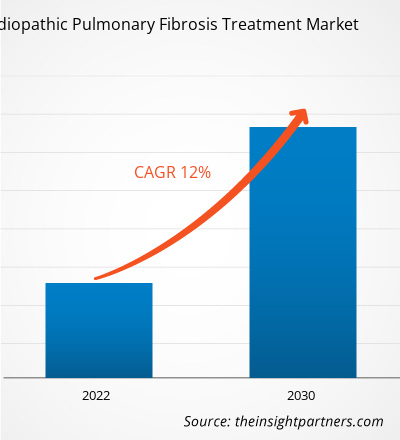[研究报告] 特发性肺纤维化治疗市场规模预计将从 2022 年的 43.6087 亿美元激增至 2030 年的 107.8407 亿美元;预计 2022-2030 年期间市场复合年增长率为 12.0%。
分析师观点:
特发性肺纤维化是一种影响肺部肺泡周围组织的慢性疾病。当肺组织因不明原因变得僵硬和增厚时,就会发生这种疾病,这些变化会随着时间的推移导致肺部永久性疤痕,使患者呼吸困难。目前,特发性肺纤维化尚无精确的治疗方法。肺部康复、药物和外科手术等治疗方法可以减缓肺部损伤并有助于提高患者的生活质量。
这 特发性肺纤维化患病率的不断上升和吸烟人数的不断增加推动了未来几年对有效治疗药物的需求。正在进行的针对特发性肺纤维化治疗的有效药物的研究工作可能会在未来进一步惠及市场。目前,发达市场和新兴市场的医疗保健支出都在增加,预计这将鼓励该市场的制造商集中精力开发新的创新产品。
市场概况:
纤维化是正常愈合过程中发生的结缔组织沉积,或病理过程中发生的多余组织沉积。特发性肺纤维化会影响肺部和肺泡(肺部气囊)中的结缔组织。这种疾病可能会导致人们在执行日常任务时呼吸困难,而这对于身体健康的人来说并不累。特发性肺纤维化治疗市场的增长归因于纤维化疾病负担的增加和吸烟人数的激增。快速发展的研发活动导致治疗技术进步,预计将在未来几年为特发性肺纤维化治疗市场提供增长机会。
定制此报告以满足您的需求
您可以免费定制任何报告,包括本报告的部分内容、国家级分析、Excel 数据包,以及为初创企业和大学提供优惠和折扣
- 获取此报告的关键市场趋势。这个免费样品将包括数据分析,从市场趋势到估计和预测。
市场驱动因素:
日益增加的负担特发性肺纤维化推动特发性肺纤维化治疗市场
根据美国肺脏协会 2022 年 11 月更新的数据,美国每年约有 50,000 例特发性肺纤维化新病例被诊断出来。这种疾病的症状在 50-70 岁的患者中更为明显。根据 2022 年 9 月发表在《英国医学杂志》上的一篇文章,2021 年专科护理单位特发性肺纤维化的估计患病率为每 100,000 人 36.0 人。由于衰老、肥胖、高血压 (高血压) 或家族史等常见风险因素,全球患有特发性肺纤维化的患者数量正在增加,这种疾病正在成为经济的重大社会经济负担。因此,特发性肺纤维化患者数量的增加推动了纤维化疾病治疗市场的增长。 fibrotic disease treatment market growth.
节段分析:
根据药物类型,特发性肺纤维化治疗市场细分为尼达尼布、吡非尼酮和其他药物。尼达尼布细分市场在 2022 年占据了更大的市场份额。预计其他细分市场在 2022-2030 年期间的复合年增长率将达到 46.3%。吡非尼酮和尼达尼布是治疗纤维化疾病的常用药物。
区域分析:
北美在全球特发性肺纤维化治疗市场中占据主导地位。2022 年北美市场价值为 23.6295 亿美元,预计到 2030 年将达到 55.2728 亿美元;预计 2022-2030 年期间的复合年增长率为 11.2%。北美特发性肺纤维化治疗市场分为美国、加拿大和墨西哥。特发性肺纤维化负担的增加和治疗技术的进步使北美特发性肺纤维化治疗市场受益。主要市场参与者的产品发布和战略举措也促进了市场增长。随着治疗特发性肺纤维化的研发活动越来越多,改进的药物被引入市场,从而使更广泛的患者群体能够更好地获得药物。此外,该地区广泛的 FDA 批准鼓励公司推出技术先进的产品。
随着特发性肺纤维化患病率的上升和高昂的医疗支出,欧洲在全球纤维化疾病治疗市场中占有第二大份额。由于德国在医疗保健领域更容易获得技术先进的产品和服务,预计它将主导欧洲特发性肺纤维化治疗市场。
预计 2022-2030 年期间,亚太地区将在全球特发性肺纤维化治疗市场中实现最快的复合年增长率。预计的市场增长可以归功于尖端技术的广泛接受和采用,这些技术可以在更短的时间内产生准确的结果。该地区的医疗保健行业正在利用人工智能、自动化和数字化转型方面的创新,提高医疗专业人员的效率和生产力。各个行业的持续转型增强了亚太地区的企业和经济,使它们能够将自己定位为发展最快的中心,并采取动态和前瞻性的方法实现可持续发展。
关键球员分析:
特发性肺纤维化治疗市场分析基于 Genentech, Inc. 和 Boehringer Ingelheim International GmbH 等主要参与者。
特发性肺纤维化治疗市场区域洞察
Insight Partners 的分析师已详尽解释了预测期内影响特发性肺纤维化治疗市场的区域趋势和因素。本节还讨论了特发性肺纤维化治疗市场在北美、欧洲、亚太地区、中东和非洲以及南美和中美的细分市场和地理位置。

- 获取特发性肺纤维化治疗市场的区域特定数据
特发性肺纤维化治疗市场报告范围
| 报告属性 | 细节 |
|---|---|
| 2022 年市场规模 | 43.6087亿美元 |
| 2030 年市场规模 | 107.8407 亿美元 |
| 全球复合年增长率(2022 - 2030 年) | 12.0% |
| 史料 | 2020-2022 |
| 预测期 | 2022-2030 |
| 涵盖的领域 | 按药物类型
|
| 覆盖地区和国家 | 北美
|
| 市场领导者和主要公司简介 |
|
特发性肺纤维化治疗市场参与者密度:了解其对业务动态的影响
特发性肺纤维化治疗市场正在快速增长,这得益于终端用户需求的不断增长,而这些需求又源于消费者偏好的不断变化、技术进步以及对产品优势的认识不断提高等因素。随着需求的增加,企业正在扩大其产品范围,进行创新以满足消费者的需求,并利用新兴趋势,从而进一步推动市场增长。
市场参与者密度是指在特定市场或行业内运营的企业或公司的分布情况。它表明在给定市场空间中,相对于其规模或总市场价值,有多少竞争对手(市场参与者)存在。
在特发性肺纤维化治疗市场运营的主要公司有:
- 勃林格殷格翰国际有限公司
- 百时美施贵宝公司
- F. 霍夫曼-罗氏有限公司
- 阿斯利康
- 盐野义工业株式会社
免责声明:上面列出的公司没有按照任何特定顺序排列。

- 了解特发性肺纤维化治疗市场顶级关键参与者概况
最新动态:
特发性肺纤维化治疗市场中的公司大量采用并购等无机和有机策略。以下列出了一些最新发展:
- 2023 年 5 月,勃林格殷格翰启动了突破性 IL-11 抑制剂抗体 BI 765423 的临床开发。第 1 阶段研究 (NCT05658107) 重点评估其在健康志愿者中的安全性、耐受性和药代动力学。临床前研究表明,这种抗 IL-11 药物在抑制和潜在逆转各种纤维化病例的纤维化方面取得了良好的效果。
- 2022 年 10 月,勃林格殷格翰在 FIBRONEER-IPF III 期研究中招募了首位美国患者,该研究旨在评估 BI 1015550。BI 1015550 是一种实验性磷酸二酯酶 4B (PDE4B) 抑制剂,用于治疗患有特发性肺纤维化的患者。该研究是全球 FIBRONEER 计划的一部分,该计划包括两项 III 期研究:针对特发性肺纤维化患者的 FIBRONEER-IPF 和针对患有其他进行性纤维化间质性肺病 (ILD) 的成人患者的 FIBRONEER-ILD。
- 2022年9月,Bellerophon Therapeutics, Inc.宣布,FDA接受了其目前正在进行的INOpulse的REBUILD 3期注册试验的试验规模缩减申请,该试验用于治疗纤维化间质性肺病(LD)。
- 2022年5月,全球领先的药物安全解决方案提供商ArisGlobal收购了勃林格殷格翰的BRASS数字创新。此次收购使ArisGlobal能够通过将BRASS整合到LifeSphere Clarity中来增强其LifeSphere技术平台。此次整合促进了整个行业的药物警戒和患者安全的进步。此外,ArisGlobal还在全球各个地区扩大了其临床诊断业务,巩固了其全球地位。
- 2022 年 3 月,领先制药公司百时美施贵宝宣布以每股 76.00 美元的价格通过最终合并协议收购 Turning Point Therapeutics, Inc.。此次收购大大增强了百时美施贵宝在制药市场的全球影响力,使其能够更积极地为行业带来创新,同时扩大其救命疗法和治疗组合。
- 历史分析(2 年)、基准年、预测(7 年)及复合年增长率
- PEST 和 SWOT 分析
- 市场规模价值/数量 - 全球、区域、国家
- 行业和竞争格局
- Excel 数据集



Report Coverage
Revenue forecast, Company Analysis, Industry landscape, Growth factors, and Trends

Segment Covered
This text is related
to segments covered.

Regional Scope
North America, Europe, Asia Pacific, Middle East & Africa, South & Central America

Country Scope
This text is related
to country scope.
常见问题
The global fibrotic diseases treatment market, based on treatment, is segmented into drug type and distribution channel. Based on drug type, the idiopathic pulmonary fibrosis treatment market is segmented into nintedanib, pirfenidone, and others. The nintedanib segment held a larger market share in 2022. The others segment is anticipated to register a higher CAGR of 46.3% during 2022–2030. Pirfenidone and nintedanib are the popular medicines prescribed to treat fibrotic diseases.
By distribution channel, the global idiopathic pulmonary fibrosis treatment market is categorized into hospital pharmacies, retail pharmacies, and online pharmacies. The hospital pharmacies segment held the largest market share in 2022. The online pharmacies segment is anticipated to register the highest CAGR of 17.4% during 2022–2030.
The enteral nutrition market is expected to be valued at US$ 10,784.07 million in 2030.
The fibrotic diseases treatment market was valued at US$ 4,360.87 million in 2022.
The fibrotic diseases treatment market majorly consists of the players such as F. Hoffmann-La Roche Ltd; C.H. Boehringer Ingelheim International GmbH; AstraZeneca.; Bristol-Myers Squibb Company; Shionogi and Co. Ltd.; and Cipla Ltd.
Idiopathic pulmonary fibrosis is a chronic condition that affects the tissue surrounding the alveoli in the lungs. It develops when lung tissues become stiff and thick for unknown reasons, and these changes result in permanent scarring in the lungs over time, which makes breathing difficult among patients. Currently, there is no precise cure for idiopathic pulmonary fibrosis. Treatments such as pulmonary rehabilitation, medicines, and surgical procedures slow down lung damage and help enhance the quality of patients’ lives.
The growth of the idiopathic pulmonary fibrosis treatment market is attributed to the surging burden of idiopathic pulmonary fibrosis and the increasing number of people smoking cigarettes.
Trends and growth analysis reports related to Life Sciences : READ MORE..
The List of Companies - Fibrotic Diseases Treatment Market
- C.H. Boehringer Ingelheim International GmbH
- Bristol-Myers Squibb Company
- F. Hoffmann-La Roche Ltd
- AstraZeneca
- Shionogi and Co. Ltd.
- Cipla Ltd
- Others
The Insight Partners performs research in 4 major stages: Data Collection & Secondary Research, Primary Research, Data Analysis and Data Triangulation & Final Review.
- Data Collection and Secondary Research:
As a market research and consulting firm operating from a decade, we have published and advised several client across the globe. First step for any study will start with an assessment of currently available data and insights from existing reports. Further, historical and current market information is collected from Investor Presentations, Annual Reports, SEC Filings, etc., and other information related to company’s performance and market positioning are gathered from Paid Databases (Factiva, Hoovers, and Reuters) and various other publications available in public domain.
Several associations trade associates, technical forums, institutes, societies and organization are accessed to gain technical as well as market related insights through their publications such as research papers, blogs and press releases related to the studies are referred to get cues about the market. Further, white papers, journals, magazines, and other news articles published in last 3 years are scrutinized and analyzed to understand the current market trends.
- Primary Research:
The primarily interview analysis comprise of data obtained from industry participants interview and answers to survey questions gathered by in-house primary team.
For primary research, interviews are conducted with industry experts/CEOs/Marketing Managers/VPs/Subject Matter Experts from both demand and supply side to get a 360-degree view of the market. The primary team conducts several interviews based on the complexity of the markets to understand the various market trends and dynamics which makes research more credible and precise.
A typical research interview fulfils the following functions:
- Provides first-hand information on the market size, market trends, growth trends, competitive landscape, and outlook
- Validates and strengthens in-house secondary research findings
- Develops the analysis team’s expertise and market understanding
Primary research involves email interactions and telephone interviews for each market, category, segment, and sub-segment across geographies. The participants who typically take part in such a process include, but are not limited to:
- Industry participants: VPs, business development managers, market intelligence managers and national sales managers
- Outside experts: Valuation experts, research analysts and key opinion leaders specializing in the electronics and semiconductor industry.
Below is the breakup of our primary respondents by company, designation, and region:

Once we receive the confirmation from primary research sources or primary respondents, we finalize the base year market estimation and forecast the data as per the macroeconomic and microeconomic factors assessed during data collection.
- Data Analysis:
Once data is validated through both secondary as well as primary respondents, we finalize the market estimations by hypothesis formulation and factor analysis at regional and country level.
- Macro-Economic Factor Analysis:
We analyse macroeconomic indicators such the gross domestic product (GDP), increase in the demand for goods and services across industries, technological advancement, regional economic growth, governmental policies, the influence of COVID-19, PEST analysis, and other aspects. This analysis aids in setting benchmarks for various nations/regions and approximating market splits. Additionally, the general trend of the aforementioned components aid in determining the market's development possibilities.
- Country Level Data:
Various factors that are especially aligned to the country are taken into account to determine the market size for a certain area and country, including the presence of vendors, such as headquarters and offices, the country's GDP, demand patterns, and industry growth. To comprehend the market dynamics for the nation, a number of growth variables, inhibitors, application areas, and current market trends are researched. The aforementioned elements aid in determining the country's overall market's growth potential.
- Company Profile:
The “Table of Contents” is formulated by listing and analyzing more than 25 - 30 companies operating in the market ecosystem across geographies. However, we profile only 10 companies as a standard practice in our syndicate reports. These 10 companies comprise leading, emerging, and regional players. Nonetheless, our analysis is not restricted to the 10 listed companies, we also analyze other companies present in the market to develop a holistic view and understand the prevailing trends. The “Company Profiles” section in the report covers key facts, business description, products & services, financial information, SWOT analysis, and key developments. The financial information presented is extracted from the annual reports and official documents of the publicly listed companies. Upon collecting the information for the sections of respective companies, we verify them via various primary sources and then compile the data in respective company profiles. The company level information helps us in deriving the base number as well as in forecasting the market size.
- Developing Base Number:
Aggregation of sales statistics (2020-2022) and macro-economic factor, and other secondary and primary research insights are utilized to arrive at base number and related market shares for 2022. The data gaps are identified in this step and relevant market data is analyzed, collected from paid primary interviews or databases. On finalizing the base year market size, forecasts are developed on the basis of macro-economic, industry and market growth factors and company level analysis.
- Data Triangulation and Final Review:
The market findings and base year market size calculations are validated from supply as well as demand side. Demand side validations are based on macro-economic factor analysis and benchmarks for respective regions and countries. In case of supply side validations, revenues of major companies are estimated (in case not available) based on industry benchmark, approximate number of employees, product portfolio, and primary interviews revenues are gathered. Further revenue from target product/service segment is assessed to avoid overshooting of market statistics. In case of heavy deviations between supply and demand side values, all thes steps are repeated to achieve synchronization.
We follow an iterative model, wherein we share our research findings with Subject Matter Experts (SME’s) and Key Opinion Leaders (KOLs) until consensus view of the market is not formulated – this model negates any drastic deviation in the opinions of experts. Only validated and universally acceptable research findings are quoted in our reports.
We have important check points that we use to validate our research findings – which we call – data triangulation, where we validate the information, we generate from secondary sources with primary interviews and then we re-validate with our internal data bases and Subject matter experts. This comprehensive model enables us to deliver high quality, reliable data in shortest possible time.


 获取此报告的免费样本
获取此报告的免费样本